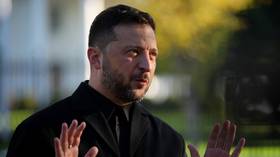US, European diplomats meet with radicals in Kiev, see ‘no threat’ from them

Western diplomats have once again come to Kiev’s Independence Square, the epicenter of protests which have evolved from democratic rallies into violent riots. Ambassadors reportedly met with leaders representing radical forces.
American, Canadian, and European diplomats arrived at
Independence Square - also known as Maidan - on Sunday, the
opposition Batkivshchyna (Fatherland) party said in a statement.
The diplomats also “inspected” the Trade Unions
Building, home to the National Resistance Headquarters. The
so-called “commandants” of Maidan, Batkivshchyna
deputies Andrey Parubiy and Stepan Kubiv, "showed" that
there were no weapons on the square or in the building.
The visit followed “disinformation by the Ukrainian
authorities and Russian TV channels about alleged stockpiles of
arms on Maidan,” the statement reads.
The foreign diplomats also reportedly met with the speaker of
Right Sector - a movement uniting several nationalist
organizations - and one of Maidan’s self defense commanders. The
diplomats were “convinced that these people posed no
threat” and that the “aggression” only comes from
government forces, as said in the press release.
"Ready to act illegally!"
Right-wing extremists from Right Sector have been widely involved
in violent clashes with police in Kiev. The group is committed to
ousting the “occupation” government at any cost.
The movement posted “instructions” for their members on
a social networking site on Monday, though the directions looked
more like a military order. The message calls on regional
commanders and their deputies to organize their subordinates in
units, conduct propaganda among the general public, and
“neutralize the anti-Ukrainian bloc” – apparently
referring to government supporters.
Additionally, Right Sector commanders must provide their units “with everything necessary” and be “ready to act illegally.” Upon request from the headquarters, they should “send people to Kiev and other regions,” the message reads.

Peaceful anti-government protests began on November 21 after Ukrainian President Viktor Yanukovich refused to sign an association agreement with the EU. Since then, a standoff between government forces and the opposition has continued, with both sides succumbing to violence.
Though thousands continue to arrive at Maidan for peaceful demonstrations, radical groups - primarily Right Sector - have moved to the forefront of the bloody confrontation. January has been marred by chaos in Kiev and several other cities, with protesters seizing administrative buildings, attacking officers with Molotov cocktails, and even setting up an improvised catapult to launch stones and firecrackers at police cordons.
Right Sector coordinator Andrey Tarasenko stated that a civil war could begin if police use heavy force against protesters.
“If they attack and try to carry out a bloody crackdown, I think there will be a massacre. Guerrilla warfare will begin in Ukraine,” he told RFE last week.
Since the beginning, the rallies have been marked by western politicians’ regular visits to Kiev and their emotional condemnations of Ukrainian authorities.
US Assistant Secretary of State Victoria Nuland was spotted on December 11 distributing cookies to protesters in central Kiev. Later in the month, Senator John McCain arrived in Kiev to show his support for the opposition. Addressing protesters in Maidan, he stated that Ukraine's future was with Europe, adding that the country would “make Europe better.”

Such pilgrimages were condemned by the ruling party’s MPs as
meddling in the country’s internal affairs. In late December, the
Ukrainian Security Service temporarily banned a number of foreign
citizens from entering the country over “national
security” concerns. The names of those denied entry were not
made public.
On Friday, US Secretary of State John Kerry reiterated
Washington’s support for Ukrainian protesters.
“We will stand with the people of Ukraine,” he said in a
speech at the World Economic Forum in Davos, Switzerland. “We
are working with our partners to press the government of Ukraine
to forego violence, to address the concerns of peaceful
protesters, to foster dialogue, promote the freedom of assembly
and expression.”
Earlier last week, the State Department urged all sides to
“immediately de-escalate the situation and refrain from
violence.”
However, so far Western politicians – who repeatedly blamed
Ukrainian government for violence – have not condemned radical
protesters for using force.
Moscow has called for a settlement of the crisis without foreign
interference. Russian Foreign Minister Sergey Lavrov said Monday
that he regrets that “outrageous violent actions of
fascist-type fellows” rioting in Ukraine have received
“no evaluation in principle” by EU bodies.















